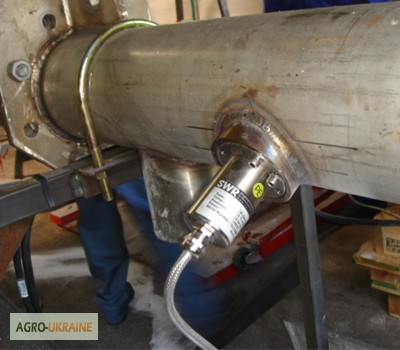TESTING OF THE MICROWAVE MOISTURE METER MANUFACTURED BY SWR-ENGINEERING (GERMANY), TYPE M-SENS2, AT KRYZHOPOL SUGAR PLANT
Early in August 2014, the sales specialist of CSC-AUTOMATION offered Kryzhopol Sugar Plant a new method of continuous metering of pulp moisture, using a microwave moisture meter.
They liked the idea, as today the automation of the drying drum is carried out by indirect method — measuring temperature of the heating agent (air) on the drum discharge. However, the main criteria of the ready dry pulp is its moisture, but not the temperature. The employees of the laboratory identify the content of dry stuff (moisture), but they do it from time to time, which does not allow to control moisture content in on-line mode. It was decided to set the moisture meter for testing.

Preliminary, on August 15, the specialists of CSC-AUTOMATION checked up product/dry pulp for the ability to measure its moisture, using test moisture meter. The positive result was obtained. The place of setting of M-Sens2 moisture meter was immediately identified, namely, on the screw of dried pulp extraction from the drying drum.
Early in September, CSC-AUTOMATION provided the mounting flange with the plug for the moisture meter. It was set by the specialists of Podillya PC (Kryzhopol Sugar Plant).
On September 9-10, the specialists of CSC-AUTOMATION delivered the moisture meter to the plant and performed pre-commissioning operations.
As a result of tests, the moisture readings were obtained, which ranged within 10-14%, and the measurement error comprised -0.2%.
Previously, the plant had SCADA one-loop system installed for drying drum control based on the principle of heating agent measurement at the discharge. The proportional current signal of 4…20 mA (by moisture) was output from the secondary instrument and added to the current Scada controller. It allowed to display the moisture readings on the monitor in numeric and graphic form. Use of M-Sens2 moisture meter allows both to see the readings and to create double-three-loop control based on the direct method — moisture measurement.
It gives the additional opportunities to control gas (fuel) flow rate, product feed (drier productivity). Beside the additional opportunities, in the process of automation, we expect to get economic effect from the reduction of gas (fuel) consumption and reduction of pulp losses in case of overdrying.
Conclusion: the test results were positive, the work of the instrument itself is stable. We recommend to use pulp driers on the sugar plants.
The economic effect of introduction of the new moisture-based automation loop will be obtained upon the end of the beet processing season.
